28/04/24
I don’t read book summaries. Neither should you. The following are mostly notes to myself for later reference, and are my interpretations.
Build by Tony Fadell is a book packed tight with decades of learning building some of the most game-changing products of our generation. This is the book I took most notes from this year (so far). I highly recommend reading this book and skip the summary. If you don't like reading books, just the read the notes below, multiple times.
Coaching, mentoring
A coach helps because they know the company; a mentor helps because they know you.
The best is a combination of the two — someone who understands both worlds — a mentor/coach who can help people see the bigger picture about what the business may need as well as what they need personally.
Everybody trying to do something meaningful needs and deserves to have a mentor and coach — someone who's seen it and done it and can hopefully help you through the toughest moments in your career.
A good mentor won't hand you the answers, but they will try to help you see your problem from a new perspective. They'll loan you some of their hard-fought advice so you can discover your own solution.
Career
The best way to find a job you'll love and a career that will eventually make you successful is to follow what you're naturally interested in, then take risks when choosing where to work. The correct place to start is this: "What do I want to learn?" and not "How much money do I want to make?", not "What title do I want to have?"
On management consultants: Just whatever you do, don't become a "management consultant" at a behemoth like McKinsey or Bain or one of the other eight consultancies that dominate the industry. They all have thousands upon thousands of employees and work almost exclusively with Fortune 5000 companies. These corporations, typically led by tentative, risk-averse CEOs, call in the management consults to do a massive audit, find the flaws, and present leadership with a new plan that will magically "fix" everything.
If you're passionate about something — something that could be solving a huge problem one day — then stick with it.
You should know where you want to go, who you want to work with, what you want to learn, who you want to become. And from there, hopefully you'll start to understand how to build what you want to build.
Bill Gurley, "I can't make you the smartest or the brightest, but it's doable to be the most knowledgeable. It's possible to gather more information than somebody else."
Ask every smart person you meet, "Who are the top three people you know and respect who you think I should talk to next? Do you mind intro0ing me really quickly?"
Managing, hiring, team
Managing upwards — You job isn't just doing your job. It's also to think like your manager or CEO. You need to understand the ultimate goal, even if it's so far away that you're not really sure what it'll look like when you get there.
Managing upwards — Come curious. And come genuinely interested. When you're looking up and around, you're not a self-serving mission to understand if your company will fail and how quickly you should cut and run. You're trying to understand how to do your job better. You're getting ideas of how to help your project and your company's mission succeed. You're starting to think like your manager or leader, which is the first step to becoming a manager or leader.
You don't have to be a manager to be successful
As a manager, you should be focused on making sure the team is producing the best possible product.
It helps to agree on the process early. So, discuss this extensively at the beginning of a project. After that, make sure everything's heading in the right direction in regular team meetings. These meetings should be structured to get you and the team as much clarity as possible.
Once you become a manager, you'll stop doing the thing that made you successful in the first place. Instead you'll be digging into how others do them, helping them improve. Your job will now be communication, communication, communication, recruiting, hiring and firing, setting budgets, reviews, one-on-one meetings, meetings with your team and other teams and leadership, representing your team in those meetings, setting goals and keeping people on track, conflict resolution, helping to find creative solutions to intractable problems, blocking and tackling political BS, mentoring your team, and asking how you can help all the time.
Management is a learned skill, not a talent.
Being exacting and expecting great work is not micromanagement.
Honesty is more important than style.
Don't worry that your team will outshine you.
If you're doing what you loved in your old job, then you're probably doing the wrong thing. You now lead a team of people doing what you used to be good at. So at least 85% of your time should be spent managing. If it's not, then you aren't doing it right.
When you close your eyes, you should already know what exactly who your first employees will be. If you don't have that list of names ready before you start, you probably shouldn't be starting.
Steve Jobs took vacations not to relax, not to avoid Apple, but to give himself a nice long time to rummage as he spent time with his family.
Instead of trying to find true balance or allowing anyone else to find it, Steve ran full tilt. He let Apple become all-consuming in a way that pushed everything else in his life, except his family, to the periphery.
Most people have experienced that kind of complete collapse of work/life balance in critical moments when the pressure's really on. But it's how Steve lived. And if you're not Steve Jobs — if you have to think about work all the time but you don't want to think about work all the time — then you need to have a system.
Calm down. Find space. Prioritise.
Tony would take several sheets of paper with him everywhere. They had all the top milestones in front of him for each of the disciplines — engineering, HR, finance, legal, marketing, facilities, etc. and everything they needed to do to reach those milestones.
Every top-level question that Tony had was on those papers. So when I was in a meeting or talking to someone, I could quickly scan it. What are the top issues? What issues do our customers have? What's the current roadblock for this person's team? What are the next major milestones? What date commitments did our team make?
After a candidate joins, there is always an awareness that nobody's perfect. There were always critiques, challenges. So it was the hiring manager's job to understand potential issues from the outset, talk them through with leadership and the candidate, and commit to coaching their new team member through those challenges.
ADD TO HIRING BLOGTony is mostly interested in three basic things: who they are, what they've done, and why they did it.What are you curious about? What do you want to learn?
Why did you leave your last job? Why didn't they fight harder? And did they leave a mess behind them? What did they do to make sure they left in the right way?
To preserve what you love, have your team write down the things they value most and build a plan to continue them.
Culture arises organically but then needs to be codified to be maintained.
Caring about the work
The job is to give a shit. To care.
If you want to build a great company/ team, you should expect excellence from every part of it.
If your expectations are that everyone puts out their best work, if you're looking at a customer support articles that will be posted on your website with the same critical eye as engineering or design, then the technical writers of those articles will feel the pressure, will bitch and moan, will get stressed out, and then they will write the most incredible support articles of their lives.
Examining the product in great detail and caring deeply about the quality of what your team is producing is not micromanagement.
As a manager, you should be focused on making sure the team is producing the best possible product.
Write down a list of what you're worried about for each project and person so you can immediately see when the list is getting too long and you need to either dive deeper or back off.
Formal reviews should simply be an exercise in writing down the things you're talking about every week.
You have to tell the team why. Why am I this passionate? Why is this mission meaningful? Why is this small detail so important that I'm flipping out right now when nobody else seems to think it matters?
If someone under you does something spectacular, that just shows the company that you've built a great team. And that you should be rewarded for it. Those are the people you have more 1:1s with, who you pull into leadership meetings, who everyone will begin to notice.
That will make it much easier for you to get promoted, because there will be no question about who can run your team when you move into another role.
Everyone wanted data so they wouldn't have to make decisions themselves. Instead of moving forward with a design, you'd hear, "Well, let's just test it." Nobody wanted to take responsibility for what they were making.
Most people don't even want to acknowledge that there are opinion-driven decisions or that they have to make them. Because if you follow your gut and your gut is wrong, then there's nowhere else to cast blame. But if all you did was follow the data and you still failed, then clearly something else was wrong. Someone else screwed up.
Mission-driven assholes: Unlike true assholes, they care. They give a damn. They listen. They work incredibly hard and push their team to be better — often against their will.
Don't let up. Expect the best — from self, from everyone else. Care deeply about the mission, team, and customers.
Pushing for greatness doesn't make you an asshole. Not tolerating mediocrity doesn't make you an asshole.
A mission-driven "asshole" might tear apart your work, but they won't attack you personally. They won't call you names or fire you for disagreeing with them. That's the difference between a mission-driven "asshole" and a controlling one.
Controlling "assholes" won't listen. They'll never admit they screwed up.
The amount of energy needed to refute bullshit is an order of magnitude higher than to produce it. — Brandolini's law.
Ask someone who's seeking your mentorship, "Are you coachable?" Which means, "Will you listen? Are you ready to learn?"
Designing
The first iPod was launched 10 months after Tony started at Apple. Godspeed.
For the first version of the iPhone, Apple gave themselves 10 weeks. Ten weeks to see if we could make it work. By the end of the first iPhone project the team had about eight hundred people working on it.
Generally any brand-new product should never take longer than 18 months to ship — w4 at the limit. The sweet spot is somewhere between 9 and 18 months.
Draw pictures. Make models. Pin mood boards. Sketch out the bones of the process in rough wireframes. Write imaginary press releases.
Create detailed mock-ups that show how a customer would travel from an ad to the website to the app and what information they would see at each touchpoint.
Write up the reactions you'd want to get from early adopters, the headlines you'd want to see from reviewers, the feelings you want to evoke in everyone.
Make it visible. Physical.
At Nest, the team gave them names (Beth) and faces. Made mood board of their home, their kids, their interests, their jobs.
They knew what brands they loved and what drove them crazy about their house and how much money they spent on heating bills in the winter.
Every product should have a story, a narrative that explains why it needs to exist and how it will solve your customer's problems. It appeals to people's rational and emotional sides. It takes complicated concepts and makes them simple. It reminds people of the problem that's being solved — it focuses on the "Why"
Nest thermostat launch
Customers were buying a $249 thermostat — they were expecting a different kind of experience. And Nest needed to exceed their expectations.
Every minute, from opening the box to reading the instructions to getting it on their wall to turning on the heat for the first time, had to be incredibly smooth. A buttery, warm, joyful experience.
And we knew Beth. Searching for a screwdriver in the kitchen drawwer — then the toolbox in the garage; no, wait, maybe it's in the drawer after all — would not make her feel warm and buttery. So they changed the prototype.
A new element was added in the box — a little screwdriver. It was sleek and cute but more importantly, it was unbelievably handy.
It was a marketing expense. And a support expense. That screwdriver saved us so much money on phone support. Instead of angry calls, we had happy customers raving online about their great experience.
And if we hadn't thought about the full customer life cycle — from discovery to support to loyalty — we would have just made the kind of tiny, one-use screwdriver that comes with IKEA furniture.
Instead, we included four heads — more than anyone needed to install the thermostat — so that people could use it for practically anything.
So that Nest stayed in their brains as long as the screwdriver stayed in their drawer. Longer.
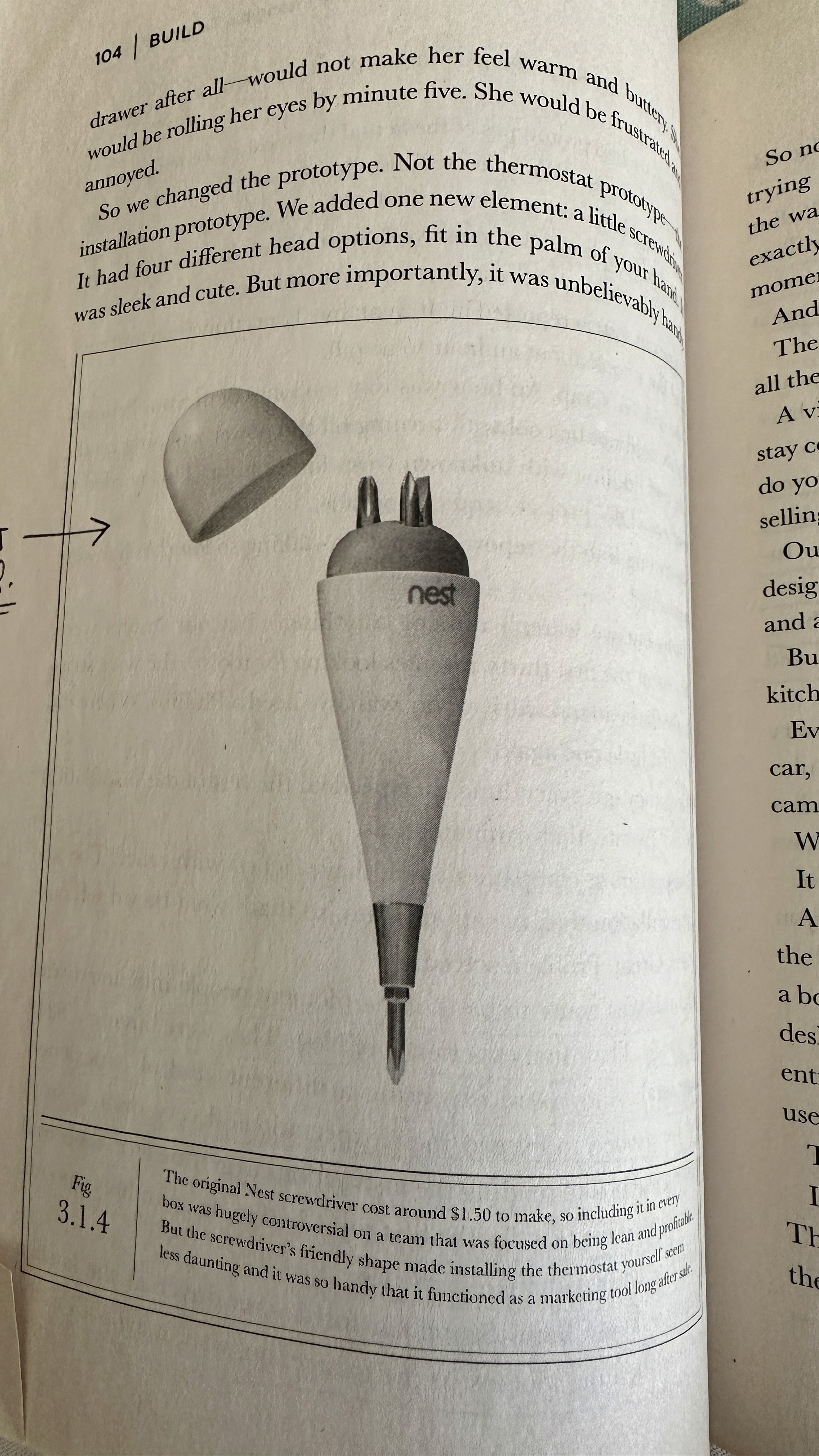
The product
For V1 of your product, take opinion-based decision. Vision (know what you want to make, why you're making it, who it's for, why people will buy it) > Customer insights > Data.
For V2, Data > Customer insights > Vision.
Deciding who's the product is for:
V1 (Innovators and early Early majority. adopters.)
These are the people who deeply love whatever it is you do — they might be gear heads or obsessed with technology or just really into your space. They'll have an emotional reaction to anything new and cool and will buy it fully aware that it will probably be buggy.
V2 (Early majority)
These are trendsetters. They watch the early adopters and will read some reviews before committing. They expect product bugs to be ironed out, decent customer support, and an easy way to learn about the purchase the product.V3 (Late majority and laggards.)
This is everyone else. The mass customers who early adopters and will expect perfection. They'll only buy the clear winner in the marketplace adn won't put up with any hassles.
Deciding the product:
V1 (Essentially shipping your prototype)
Customer acquisition costs will be sky-high; some features you really wanted will be missing; your marketing, sales, and customer support will all be a little wonky; you won't have the partnerships you'll need; and you'll still be discovering everything you got wrong.V2 (Fixing stuff you screwed up in V1)
At this stage you'll know what your problems are and how to fix them — both the unexpected issues that inevitably crop up after you launch and the stuff you cut corners on the first time. V2 usually comes swiftly after V1 because you've learned so much so fast and you're dying to get it all into the next generation.V3 (You're refining an already great product)
Your focus should be less on the product and more on the business and polishing every touchpoint of the customer lifecycle.
Outsourcing vs. building in-house:
V1 (Figuring things out and outsourcing)
You have a small team so you have to outsource a ton of functions — marketing, PR, HR, legal. This will enable you to move fast and get a lot done, but it's expensive and won't scale.V2 (Start bringing more things in-house)
You take everything you've learned from the 3rd party teams you worked with for V1 and start building that muscle in-house.V3 (Lock in internal expertise and selectively outsource smaller projects)
Certain key internal teams will be focused on the most important differentiators of your business. That may mean doing branding in-house or legal or whatever is most important to your ocmpany. As these teams grow and do more, they begin outsourcing again, but only for specific, smaller tasks that are closely supervised by the internal team.
Product & business:
V1 (PMF)
If you can't prove that at least early adopters will buy your V1, then you have to go back to the drawing board and start over.V2 (Profitable product)
You'll widen the market, start nailing more parts of the customer journey, and might even be making a little money per product — but probably not enough to cover costs.V3 (Profitable business)
Assuming you reached gross margins with V2, you may want to aim for net margins with V3. This is when you begin negotiating with partners for better deals, optimising your customer support and sales channel, and buying new kinds of media for marketing. Hopefully you'll finally get enough volume that you can start to reduce your prices and actually make real money. With V3 you have a change to get it all right — the product, the company, and your business model.
The 1st sketch and progression of what would eventually become the iPhone.
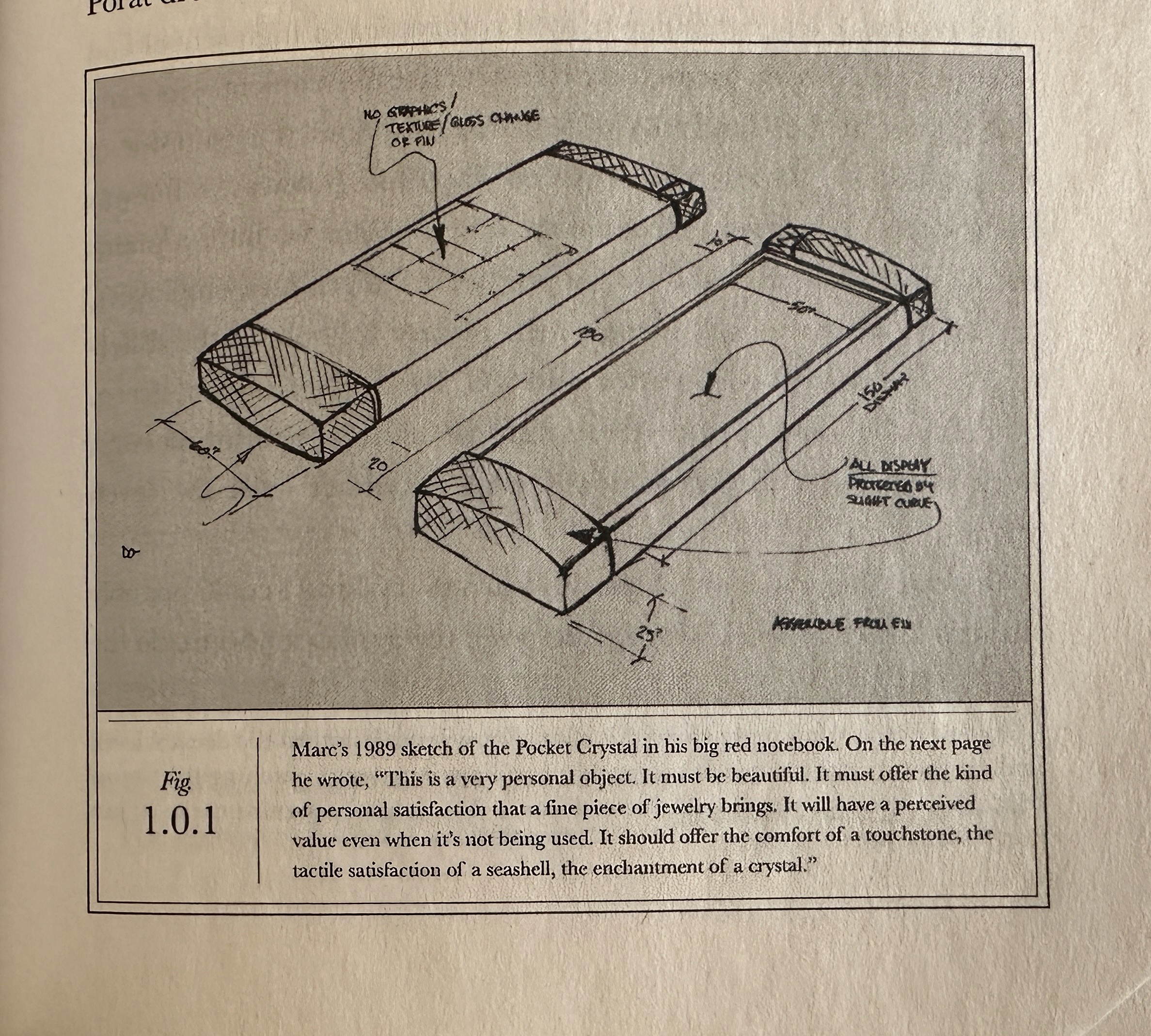
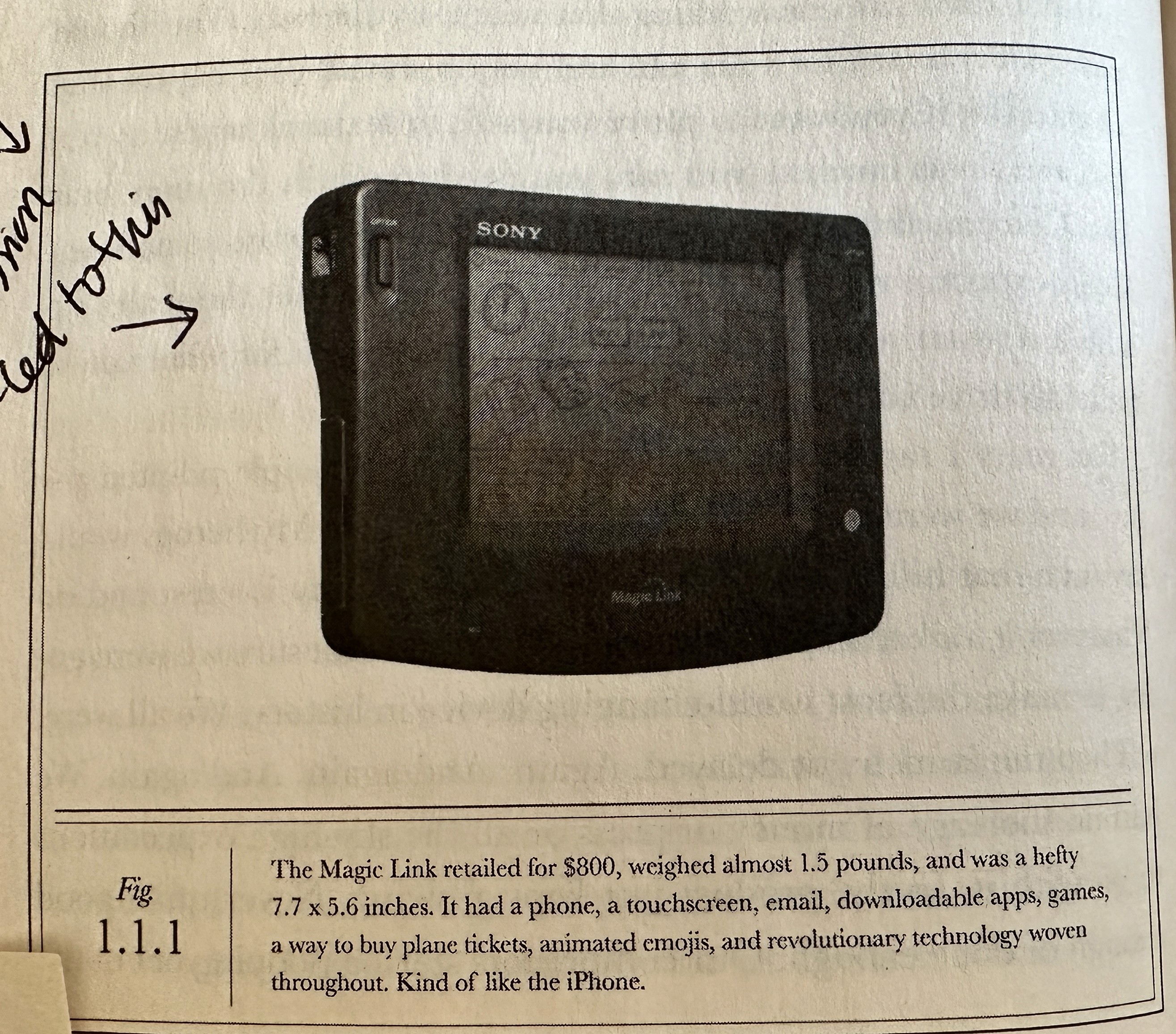
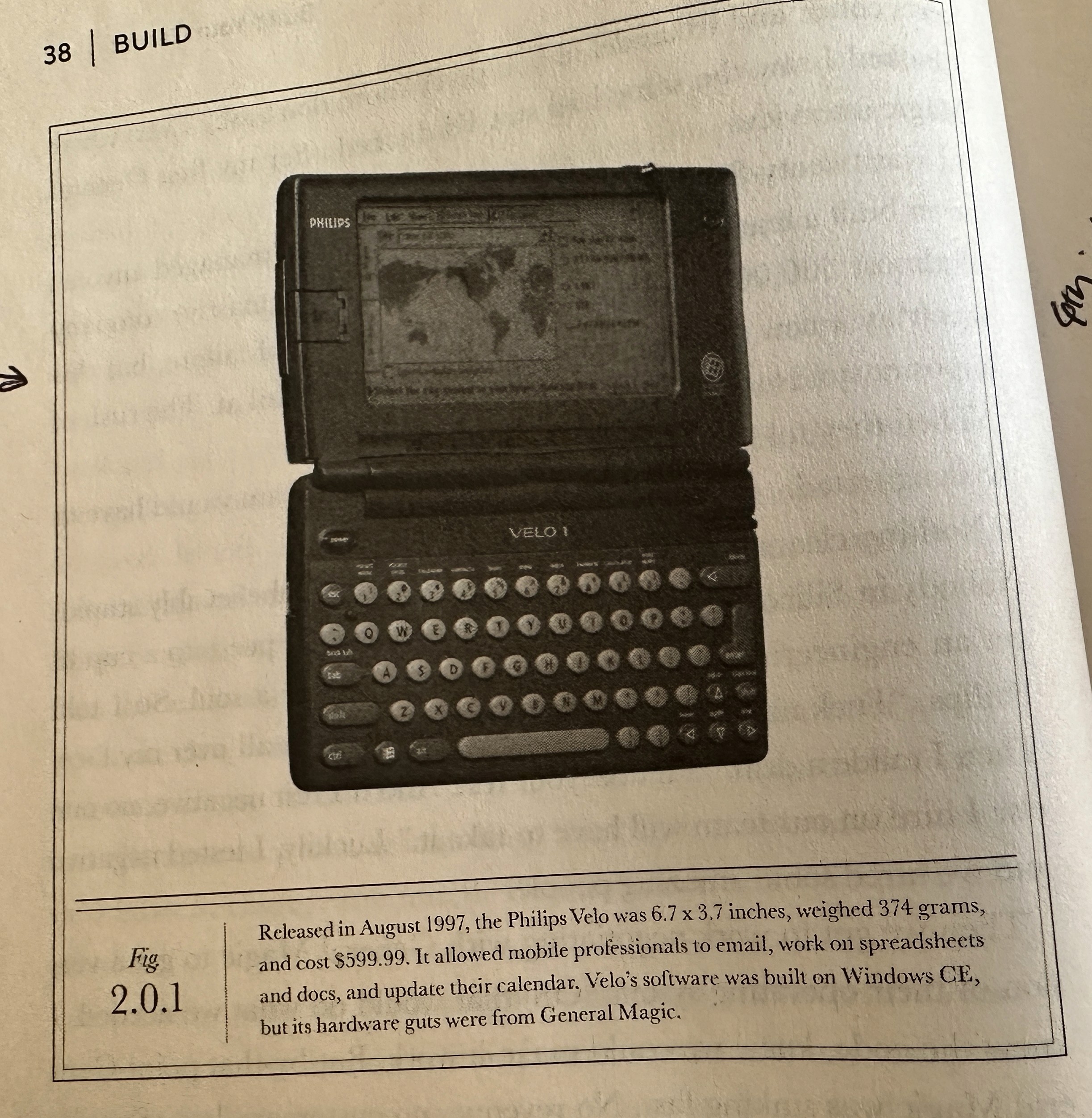
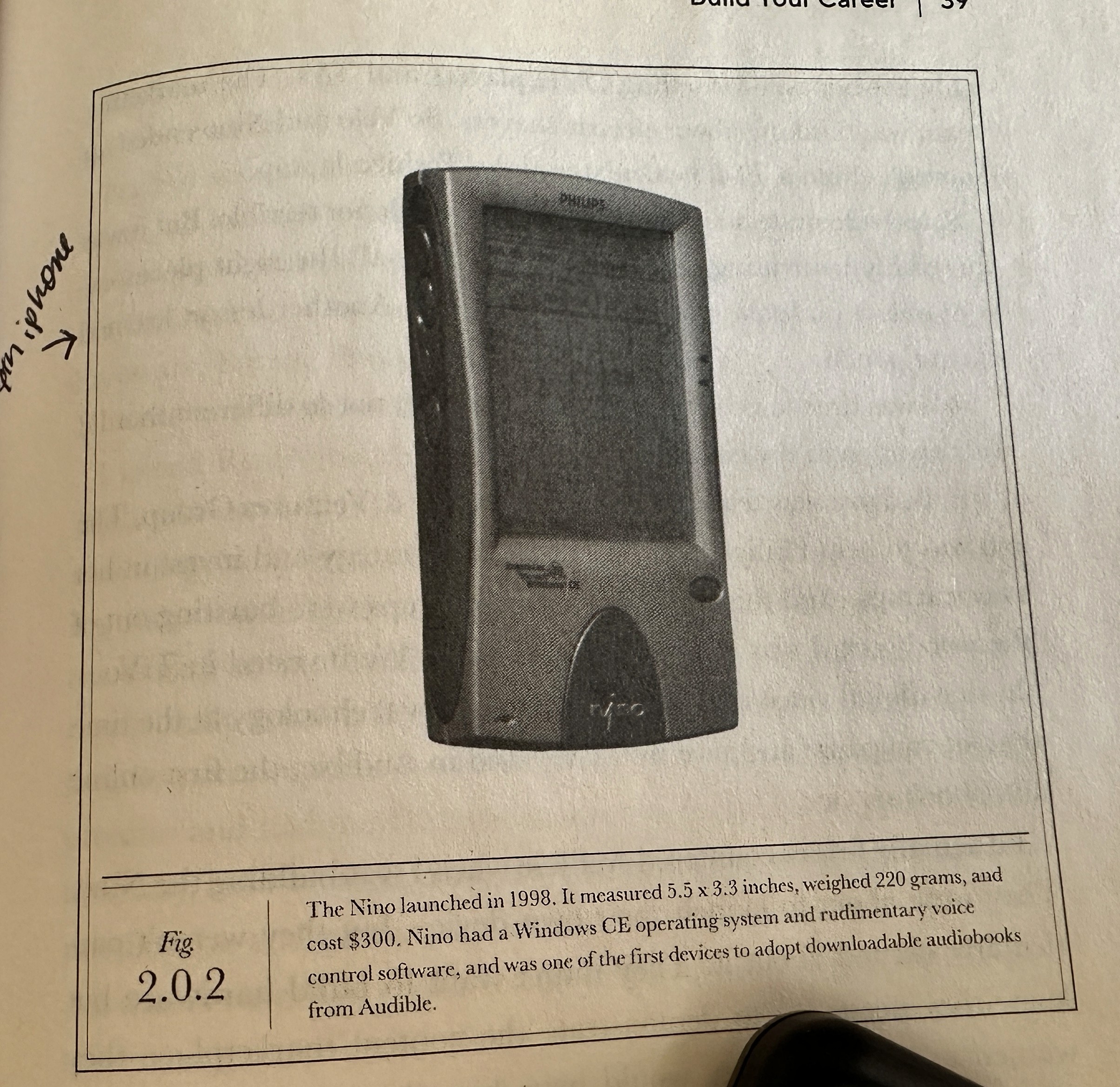
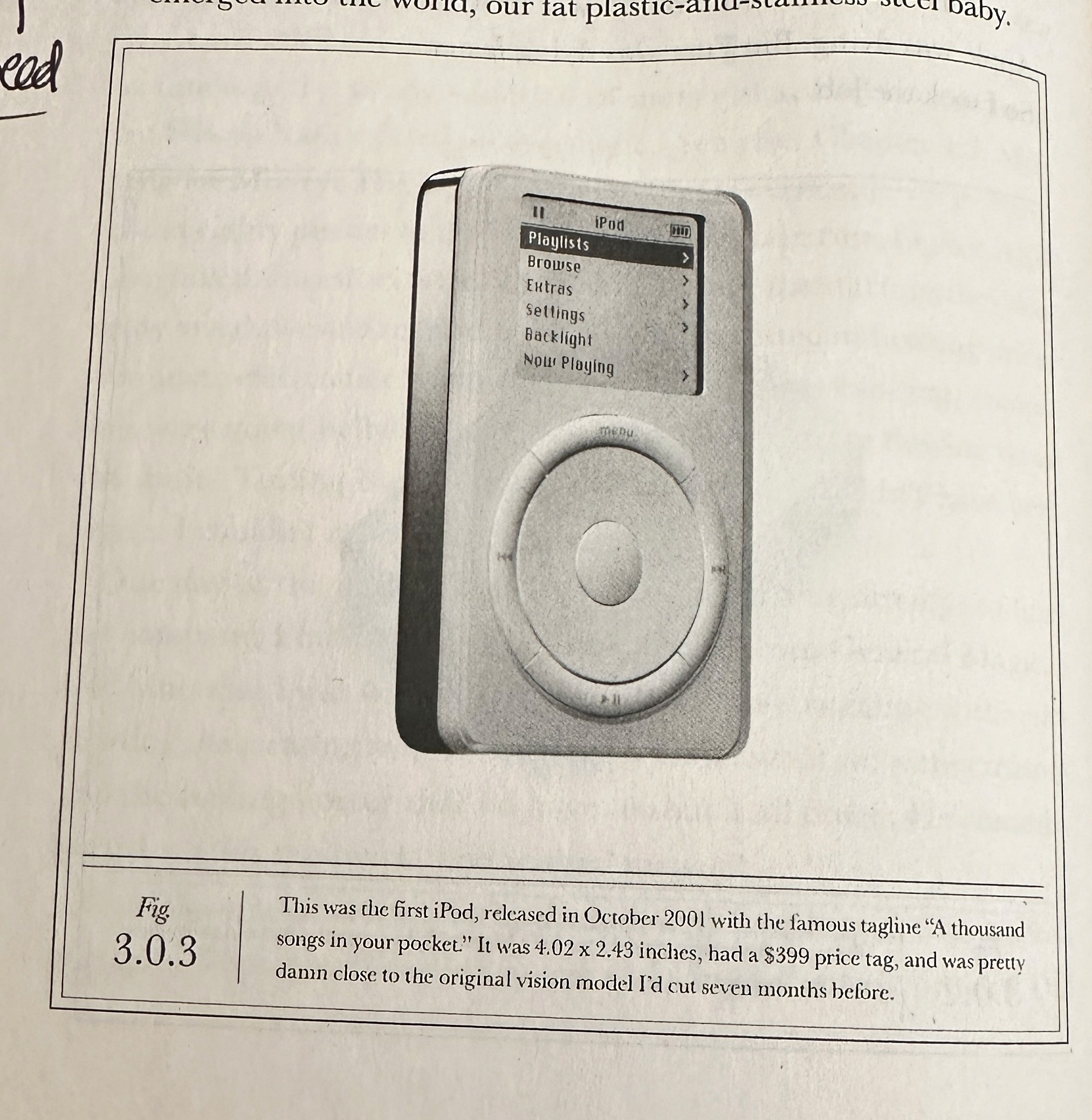
Product marketing
At Nest, the head of Marketing, Anton Oenning wrote the packaging himself more than 10 times and finally developed a messaging process and framework at the same time.
And then, after he'd built a foundational understanding of what the packaging could be and its innate limitations, after he knew the messaging in his bones, he worked with designers and copywriters to make it perfect.
But none of that could have happened if he hadn't tried it himself first.
The following is a good naming framework:
Who is your customer and where will they encounter this name?
What are you trying to get your customer to think or feel about your product?
What brand attributes or product features are most important to highlight with this name?
Is this product part of a family of products or is it stand-alone?
What will the next version be called?
Should the name be evocative of a feeling or idea or a straightforward description?
Once you come up with a list, begin to use the names in context.
How does it work in a sentence?
How do you use it in print?
How do you use it graphically?
Design everything visually. Design all touch points, experiences and put out for everyone to see. The team will begin to think like their customer: "Here's how I would want to return this product."
Solve things creatively. Steve jobs wanted people to take the iPod out of the box and instantly love and understand it. But it wasn't possible. Back then all consumer electronics with a hard drive needed to be charged before you could use them. Steve said, "We're not going to let that happen to our product."
At Apple, it was typical for electronics to run for thirty minutes in the factory to make sure they worked. We ran the iPod for more than two hours. The factory slowed down. Way down. The manufacturing team complained; costs added up.
But that extra time not only let us test the iPod completely, it also gave the battery time to fully charge.
Let people use the product immediately.
Frameworks below for reference. Example of the framework in action with Nest product:
Top-line billboards would just introduce the idea of a new kind of thermostat.
The packaging would highlight the top six features and how the product connects to your phone.
The website would emphasise energy savings and showcase how Nest fits into your daily life.
The usage guide inside the packaging would provide more detail about how to train the learning algorithm and tips for saving energy.
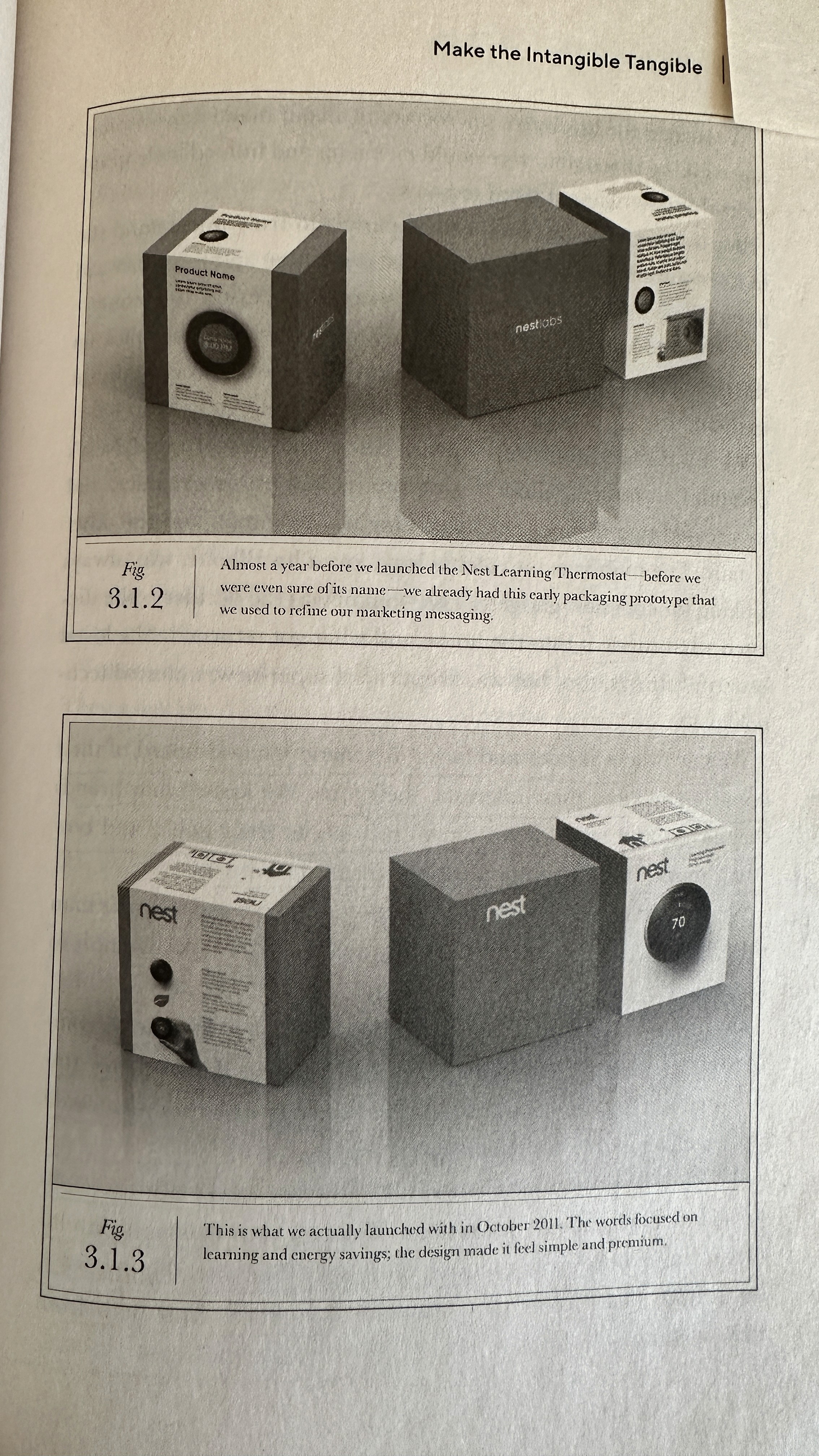
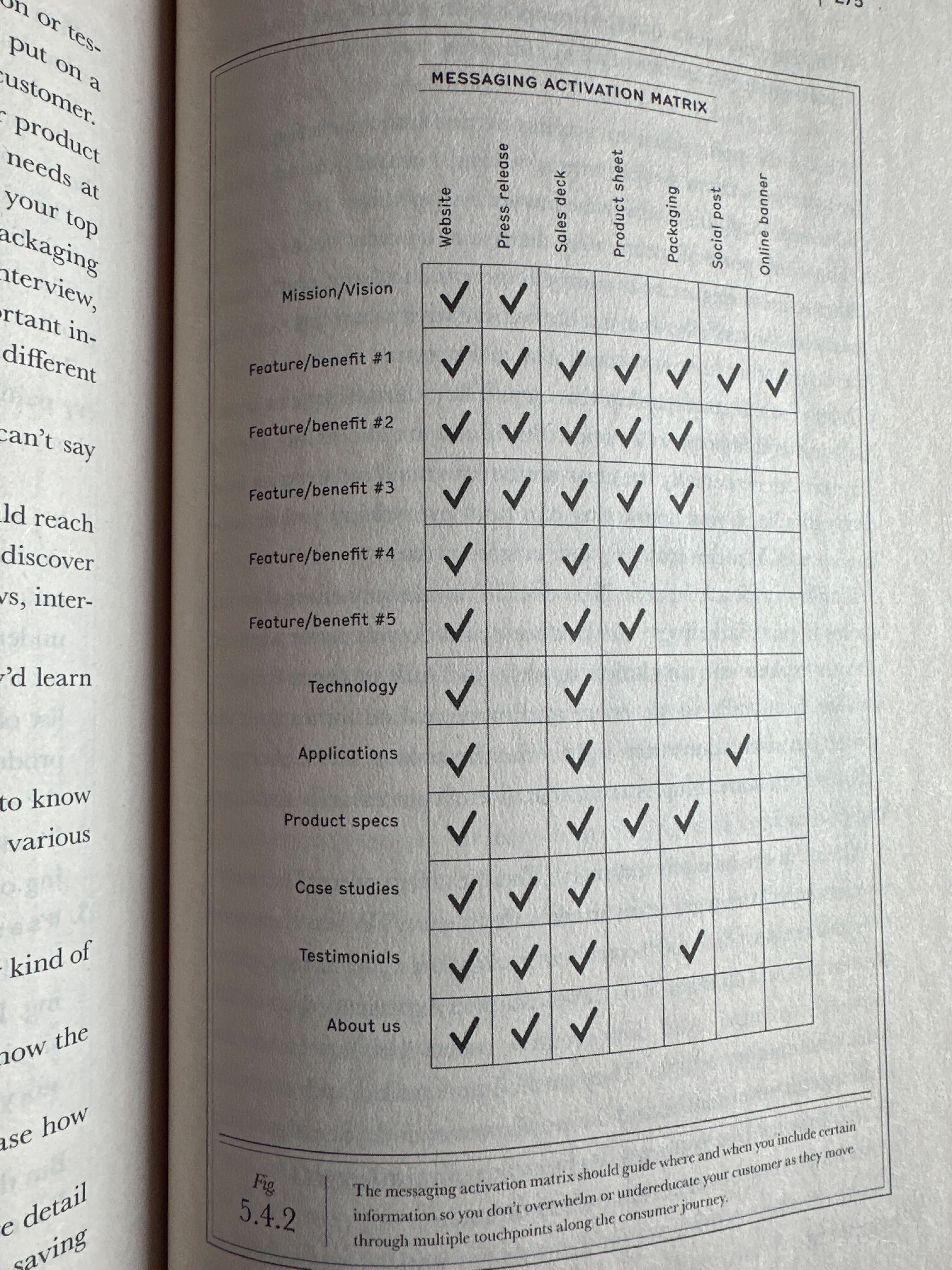
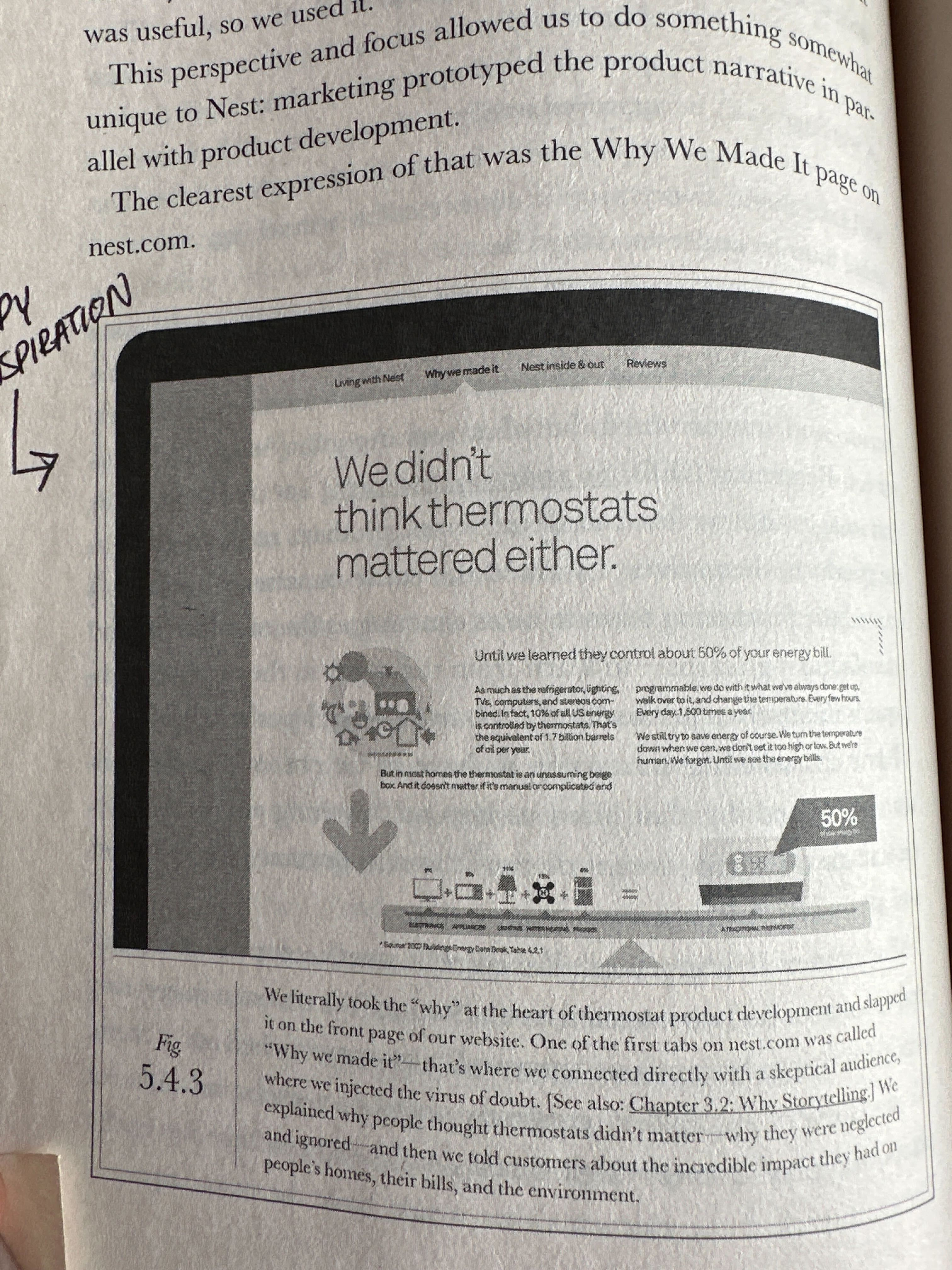
Product managers
There's no four-year college degree for product management, no obvious source you can hire from. Amazing product managers usually emerge from other roles. They start in marketing or engineering or support, but because they care so deeply about the customer, they start fixing the product and working to redefine it, rather than just executing someone else's spec or messaging.
Product-marketing and product-management are essentially the same thing — or at least they should be.
A product manager's responsibility is to figure out what the product should do and then create the spec (the description of how it will work) as well as the messaging (the facts you want customers to understand). Then they work with almost every part of the business (engineering, design, customer support, finance, sales, marketing, etc.) to get the product spec'd, built, and brought to market. They ensure that it stays true to its original intent and doesn't get watered down along the way.
But, most importantly, product managers are the voice of the customer. Their sole focus and responsibility is to build the right products of their customers.
Project managers, however, co-ordinate tasks, meetings, calendars, and assets to enable individual projects to get done on time.
Program managers supervise groups of projects and project mangers. They focus on both long-term business objectives and short-term deliverables.
A good product manager will do a great deal of all this:
Spec out what the product should do and the road map for where it will go over time
Determine and maintain the messaging matrix
Work with engineering to get the product built according to spec
Work with design to make it intuitive and attractive to the target customer
Work with marketing to help them understand the technical nuances in order to develop effective creative to communicate the messaging
Present the product to management and get feedback from the execs
Work with sales and finance to make tsure this product has a market and can eventually make money
Work with customer support to write necessary instructions, help manage problems, and take in customer requests and complaints
Work with PR to address public perceptions, write the mock press release, and often act as a spokesperson
If a product manager is making all the decisions, then they are not a good product manager.
Look-up Gred Joswiak. Tony learned product management from him. Also look-up Sophie Le Guen, a product manager at Nest.
iPod battery story
What's the point of a thousand songs in your pocket if you have to keep taking them out of your pocket to recharge? One charge had to last days, not hours.
Battery life mattered to customers. And it mattered to Steve Jobs. You couldn't just come to Steve and say, "The enxt version of the iPod is going to have a twelve-hour battery instead of fifteen like the last version." You'd get thrown out of the meeting.
So Tony and Joz didn't bring Steve numbers — they brought him customers. Commuters only used the iPod going to and from work, students used it throughout the day, but in short bursts between classes or basketball games.
They created typical customer personas, then walked through the moments in their life when they used their iPods — while jogging, at parties, in a car. And we showed Steve that even if the number engineering gave was 12 hours, those twelve hours actually lasted most people all week long.
The numbers were empty without customers, the facts meaningless without context.
How to spot a great idea
There are 3 elements to every great idea:
It solves for "Why." Long before you figure out what a product will do, you need to understand why people will want it. The "Why" drives the "What"
It solves a problem that a lot of people have in their daily lives.
It follows you around. Even after you research and learn about it and try it out and realise how hard it'll be to get it right, you can't stop thinking about it.
"To make better decisions, you need to slow down." — Daniel Kahneman
Next reads & watch
Other posts in
Books & notes
08/12/24
06/12/24
05/12/24
04/12/24
03/12/24
24/11/24
21/10/24
14/10/24
